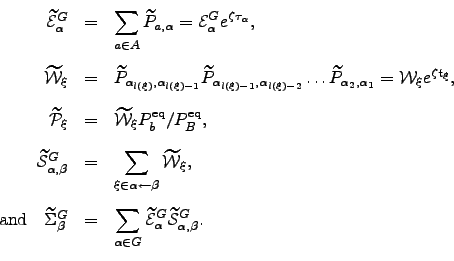



Next: Chain Graphs Up: Introduction Previous: KMC and DPS Averages Contents
Mean Escape Times
Since the mean first passage time between states  and
and  , or the escape time from a subgraph, is of particular interest, we first illustrate a means to derive formulae for these quantities in terms of pathway probabilities.
, or the escape time from a subgraph, is of particular interest, we first illustrate a means to derive formulae for these quantities in terms of pathway probabilities.
The average time taken to traverse a path  is calculated as
is calculated as  , where
, where  is the mean waiting time for escape from node
is the mean waiting time for escape from node  , as above,
, as above,  identifies the
identifies the  th node along path
th node along path  , and
, and  is the length of path
is the length of path  .The mean escape time from a graph
.The mean escape time from a graph  if started from node
if started from node  is then
is then
 | (6.20) |
If we multiply every branching probability,  , that appears in
, that appears in  by
by  then the mean escape time can be obtained as:
then the mean escape time can be obtained as:  | (6.21) |
This approach is useful if we have analytic results for the total probability  , which may then be manipulated into formulae for
, which may then be manipulated into formulae for  , and is standard practice in probability theory literature [208,209]. The quantity
, and is standard practice in probability theory literature [208,209]. The quantity  is similar to the `
is similar to the ` probability' described in Reference GoldhirschG86. Analogous techniques are usually employed to obtain
probability' described in Reference GoldhirschG86. Analogous techniques are usually employed to obtain  and higher moments of the first-passage time distribution from analytic expressions for the first-passage probability generating function (see, for example, References Raykin92,MurthyK89). We now define
and higher moments of the first-passage time distribution from analytic expressions for the first-passage probability generating function (see, for example, References Raykin92,MurthyK89). We now define  and the related quantities
and the related quantities  | (6.22) |
Note that ![$ \left[\mEt _{\alpha}^{G}\right]_{\zeta=0} = \mE _{\alpha}^{G}$](img713.png) etc., while the mean escape time can now be written as
etc., while the mean escape time can now be written as ![$\displaystyle \mathcal{T}^{G}_\beta = \left[ \frac{d\tilde{\Sigma}_\beta^{G}}{d\zeta} \right]_{\zeta=0}.$](img714.png) | (6.23) |
In the remaining sections we show how to calculate the pathway probabilities,  , exactly, along with pathway averages, such as the waiting time. Chain graphs are treated in Section 4.2 and the results are generalised to arbitrary graphs in Section 4.3.
, exactly, along with pathway averages, such as the waiting time. Chain graphs are treated in Section 4.2 and the results are generalised to arbitrary graphs in Section 4.3.




Next: Chain Graphs Up: Introduction Previous: KMC and DPS Averages Contents Semen A Trygubenko 2006-04-10 ![]() and
and ![]() , or the escape time from a subgraph, is of particular interest, we first illustrate a means to derive formulae for these quantities in terms of pathway probabilities.
, or the escape time from a subgraph, is of particular interest, we first illustrate a means to derive formulae for these quantities in terms of pathway probabilities. ![]() is calculated as
is calculated as ![]() , where
, where ![]() is the mean waiting time for escape from node
is the mean waiting time for escape from node ![]() , as above,
, as above, ![]() identifies the
identifies the ![]() th node along path
th node along path ![]() , and
, and ![]() is the length of path
is the length of path ![]() .The mean escape time from a graph
.The mean escape time from a graph ![]() if started from node
if started from node ![]() is then
is then ![$ \left[\mEt _{\alpha}^{G}\right]_{\zeta=0} = \mE _{\alpha}^{G}$](img713.png) etc., while the mean escape time can now be written as
etc., while the mean escape time can now be written as